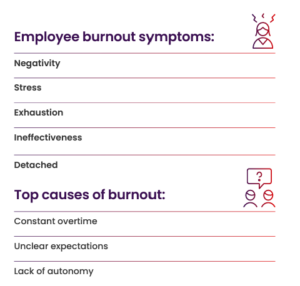4 Strategies for Combating Work-From-Home Burnout
In this blog post we help you discover how to empower your remote employees to stay engaged, maintain productivity, and foster a healthy work-life balance. Working from home offers undeniable advantages, such as eliminating the daily commute, saving on transportation costs and takeout meals, and affording more time for mid-day workouts. However, as organisations increasingly embrace hybrid or remote work arrangements, employees require extra support to prevent burnout and sustain a balanced work-life routine. 
The apparent “freedom” of remote work comes with its unique set of challenges, including juggling childcare and distance learning for working parents, attending to demanding pets, and dealing with constant interruptions from family or flatmates, which can disrupt focus and productivity. Moreover, many remote employees have fallen into unhealthy habits and lifestyles characterised by late nights, poor ergonomic setups, reduced physical activity, and an inability to disconnect from work. Compounded by the absence of in-person communication, an alarming number of individuals are experiencing heightened stress, anxiety, and burnout. To preserve your workforce’s well-being and prevent these effects from affecting your business, timely intervention is essential.
1. Empower Managers to Combat Work-From-Home Burnout
Effective remote management hinges on key traits, such as regular communication, setting clear expectations, and demonstrating genuine care for your employees. These qualities can make the difference between a remote manager leading a high-performing team and one leading a disengaged group. To nurture strong remote leadership, provide comprehensive training to your managers, outlining best practices for managing work-from-home teams. Encourage managers to understand and accommodate employees’ unique work-from-home routines and flexibility needs, like accommodating working parents who may require an earlier lunch break or more flexible hours. Equally important is educating managers about stress and burnout, enabling them to recognise the signs and offer appropriate support when necessary.
2. Review Your Company’s Culture
Does your organisation discourage overtime, or is it celebrated and rewarded? Do managers set the example when it comes to work-life balance? Are your employees properly informed and consulted about changes that affect them? Senior leadership and HR departments may believe they have the answers to these questions, but it is vital to solicit feedback directly from your employees to gain a comprehensive understanding of their experiences. Launch an employee well-being survey to glean insights into your organisation’s work-from-home culture and identify areas where change may be necessary to better align with the needs of your remote workforce.
3. Promote Healthy Habits
Small, daily changes can lead to long-term results. Encourage your employees to prioritise healthy habits, such as taking breaks to enjoy fresh air, engaging in regular exercise, maintaining a balanced diet, practising mindfulness, and pursuing relaxing hobbies. Consider scheduling online Zoom sessions to motivate your workforce with group workouts, virtual team lunches, or meditation breaks. A digital well-being solution can inspire your employees to prioritise various aspects of wellness while working from home, including physical health, mental well-being, financial literacy, and work-life balance. This tool enables employees to learn and gradually adopt healthier habits that align with their individual needs and lifestyles, keeping them connected, accountable, and on track to achieve their personal health and well-being goals.
4. Equip Employees with Stress Management Tools
While a single meditation session may provide temporary relief, instructing employees in a variety of stress and anxiety reduction techniques and offering the necessary resources can lead to lasting lifestyle changes. A holistic digital well-being solution not only offers tools and resources to support mental health but also provides a morale boost for your workforce. Features such as employee recognition, chat functions, and incentives provide your employees with reasons to stay engaged and excited. Being digital, this solution allows you to reach employees wherever they are. Coupled with a healthy habit challenge component, it fosters social camaraderie, ensuring that your employees feel connected and motivated to achieve their personal goals.
If you would like support with your remote worker well-being strategy please don’t hesitate to get in touch.

Hannah Powell
Categories
- Coaching (9)
- CSR (1)
- Culture (1)
- Culture & Engagement (33)
- Diversity and Inclusion (16)
- Employment law (38)
- Inspiration (12)
- Leadership (14)
- Learning & Development (7)
- Recruitment (12)
- Reward (9)
- Self-development (2)
- Tips & tricks (11)
- Uncategorized (18)
- Welfare and Wellbeing (26)

